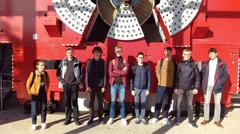The winning team “Supercooling” from Reims in front of the ARGUS detector at DESY. Credit: DESY
“We are very happy to be here and very excited to see how our experiment will go,” says Matthieu Ducret from École du Sacré-Coeur in Reims, France. The 17-year-old is one of seven students who will spend the next two weeks at DESY like real researchers - including safety briefings, shift work and data analysis. Team "Supercooling" is one of three winning teams of this year's high school competition “CERN Beamline for Schools”; the other two teams, which come from Spain and Egypt, conduct their experiments at the CERN research centre in Switzerland. They are supported by scientists from the two research centres.
When CERN launched the competition “Beamline for Schools” in 2014, in which young people submit ideas for experiments on a real particle beam and then carry them out on site, it was unclear whether there would be a second edition. It turned out to be a runaway success and has become something of an institution; a total of more than 14,000 students from all over the world have already submitted proposals for experiments. This year, the three winning teams were selected from a total of 304 team applications from 84 countries.
For the last three years, DESY was the venue for the competition because the particle accelerators at CERN were shut down for repairs. The accelerators are now running again - but DESY still hosts awinning team this year. “We are very happy to provide our beamline and support so that as many young people as possible can have the experience of living like a real scientist for a fortnight,” says Marcel Stanitzki, BL4S project leader at DESY. “The quality of the proposals was again very high this year - with the right support, students are definitely able to tackle complex topics in modern physics and develop a full research plan.”
The “Supercooling” team aims to test an innovative method of detecting particles based on the phase transition between liquid and solid water. Inspired by the detection principle used in fog and bubble chambers, the team will investigate the detection efficiency of water in a supercooled state, where the passage of high-energy particles could cause a phase transition from liquid to solid. “I am excited for the opportunity to work with a real particle accelerator,” says 17-year-old Antoine Jurion.
“Through Beamline for Schools, we have become a close-knit team, using the skills of each individual to bring out the best in us,” says Brewen Le Grand from the "Supercooling" team. His teammate Clémence Calvet adds, “This competition is a fantastic way to gain new skills and knowledge and immerse yourself in the world of physics.”
“I am thrilled that we are hosting a team again this year as part of the Beamline for Schools initiative at DESY,” says Beate Heinemann, Director of Particle Physics at DESY. “I wish all three teams lots of success and of course lots of exciting data!”
https://beamlineforschools.cern








